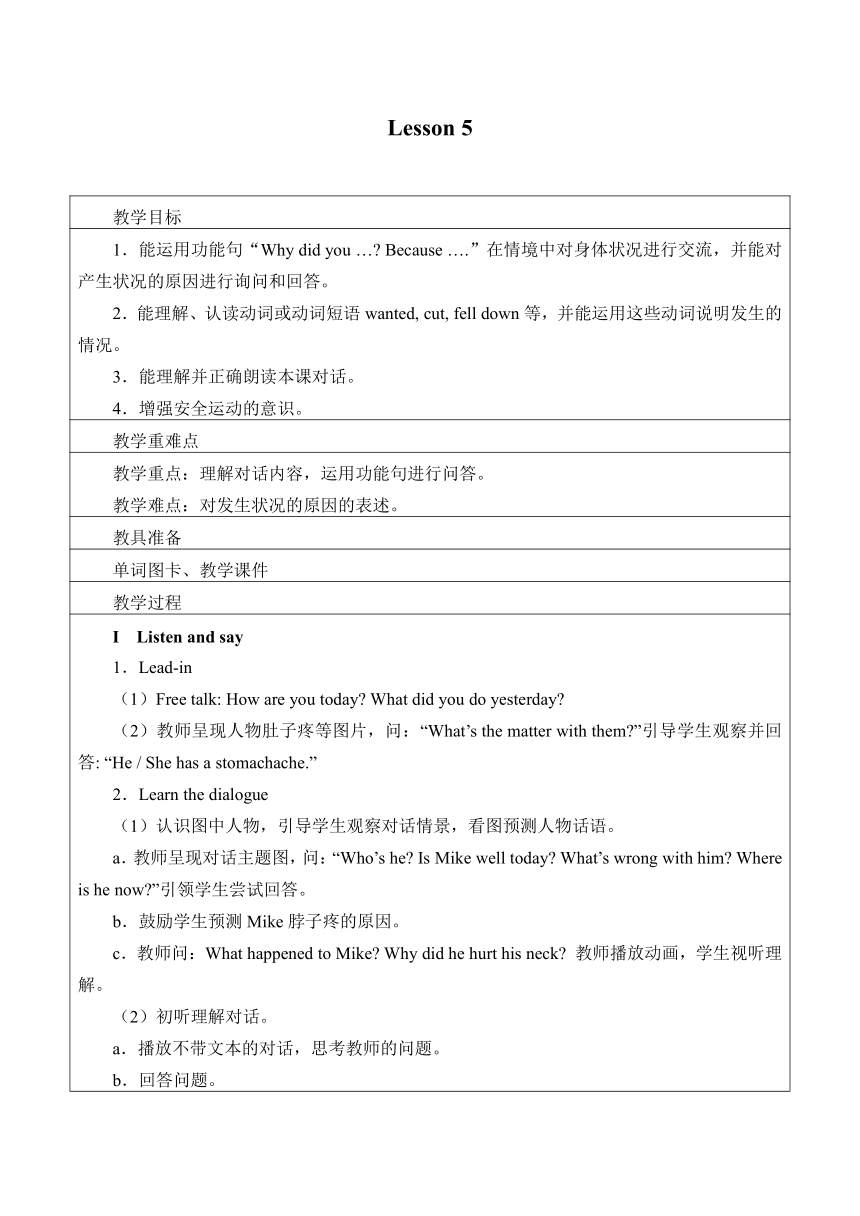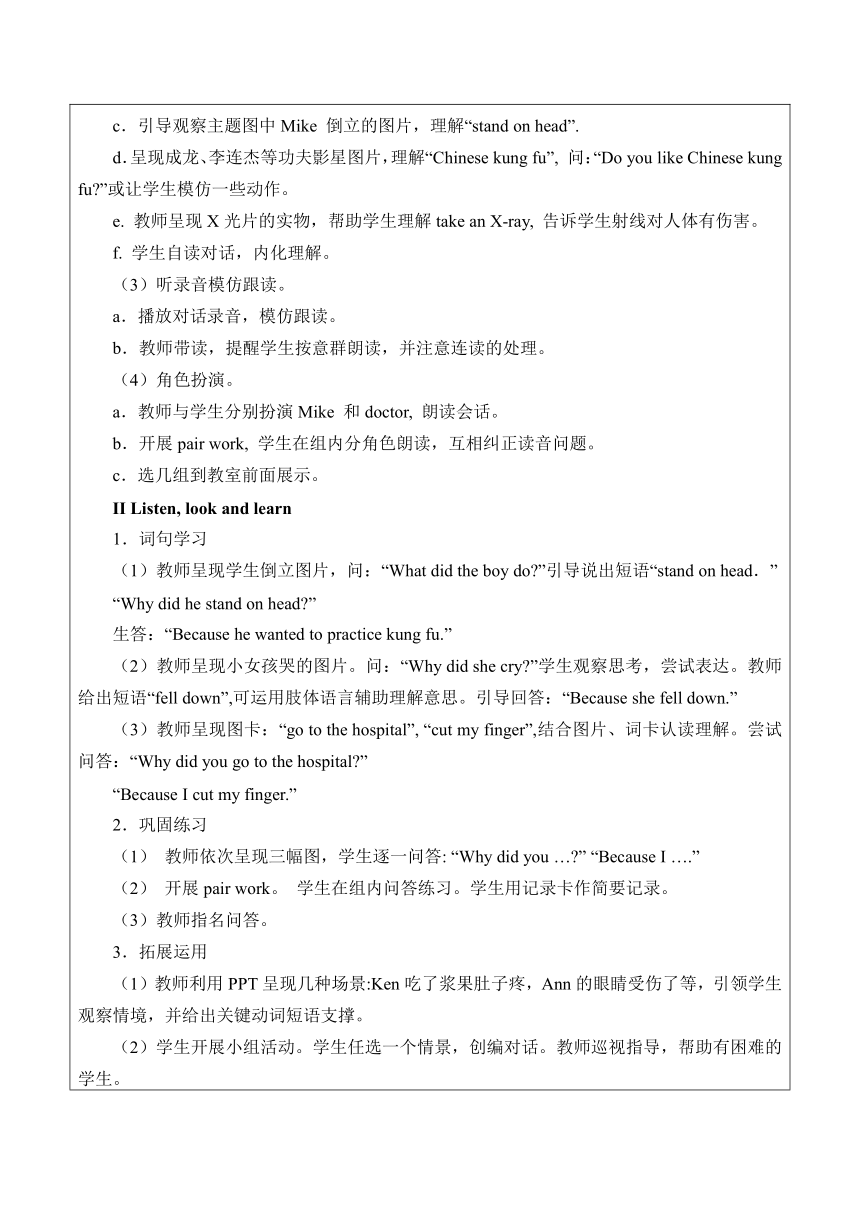Unit 2 What happened to your neck? Lesson 5 教案
文档属性
| 名称 | Unit 2 What happened to your neck? Lesson 5 教案 |  | |
| 格式 | zip | ||
| 文件大小 | 21.5KB | ||
| 资源类型 | 教案 | ||
| 版本资源 | 北京版 | ||
| 科目 | 英语 | ||
| 更新时间 | 2020-04-26 16:10:56 | ||
图片预览


文档简介
Lesson 5
教学目标
1.能运用功能句“Why did you …? Because ….”在情境中对身体状况进行交流,并能对产生状况的原因进行询问和回答。
2.能理解、认读动词或动词短语wanted, cut, fell down等,并能运用这些动词说明发生的情况。
3.能理解并正确朗读本课对话。
4.增强安全运动的意识。
教学重难点
教学重点:理解对话内容,运用功能句进行问答。
教学难点:对发生状况的原因的表述。
教具准备
单词图卡、教学课件
教学过程
I Listen and say
1.Lead-in
(1)Free talk: How are you today? What did you do yesterday?
(2)教师呈现人物肚子疼等图片,问:“What’s the matter with them?”引导学生观察并回答: “He / She has a stomachache.”
2.Learn the dialogue
(1)认识图中人物,引导学生观察对话情景,看图预测人物话语。
a.教师呈现对话主题图,问:“Who’s he? Is Mike well today? What’s wrong with him? Where is he now?”引领学生尝试回答。
b.鼓励学生预测Mike脖子疼的原因。
c.教师问:What happened to Mike? Why did he hurt his neck? 教师播放动画,学生视听理解。
(2)初听理解对话。
a.播放不带文本的对话,思考教师的问题。
b.回答问题。
c.引导观察主题图中Mike 倒立的图片,理解“stand on head”.
d.呈现成龙、李连杰等功夫影星图片,理解“Chinese kung fu”, 问:“Do you like Chinese kung fu?”或让学生模仿一些动作。
e. 教师呈现X光片的实物,帮助学生理解take an X-ray, 告诉学生射线对人体有伤害。
f. 学生自读对话,内化理解。
(3)听录音模仿跟读。
a.播放对话录音,模仿跟读。
b.教师带读,提醒学生按意群朗读,并注意连读的处理。
(4)角色扮演。
a.教师与学生分别扮演Mike 和doctor, 朗读会话。
b.开展pair work, 学生在组内分角色朗读,互相纠正读音问题。
c.选几组到教室前面展示。
II Listen, look and learn
1.词句学习
(1)教师呈现学生倒立图片,问:“What did the boy do?”引导说出短语“stand on head.”
“Why did he stand on head?”
生答:“Because he wanted to practice kung fu.”
(2)教师呈现小女孩哭的图片。问:“Why did she cry?”学生观察思考,尝试表达。教师给出短语“fell down”,可运用肢体语言辅助理解意思。引导回答:“Because she fell down.”
(3)教师呈现图卡:“go to the hospital”, “cut my finger”,结合图片、词卡认读理解。尝试问答:“Why did you go to the hospital?”
“Because I cut my finger.”
2.巩固练习
(1) 教师依次呈现三幅图,学生逐一问答: “Why did you …?” “Because I ….”
(2) 开展pair work。 学生在组内问答练习。学生用记录卡作简要记录。
(3)教师指名问答。
3.拓展运用
(1)教师利用PPT呈现几种场景:Ken吃了浆果肚子疼,Ann的眼睛受伤了等,引领学生观察情境,并给出关键动词短语支撑。
(2)学生开展小组活动。学生任选一个情景,创编对话。教师巡视指导,帮助有困难的学生。
(3)小组展示。评价反馈。
III Listen and decide
1.打开书,快速浏览并阅读三个句子。
2.教师播放录音,学生根据录音进行判断。
3.订正答案。
IV Let’s do
1.教师提问一个学生:“When did you last see the doctor?” “What was wrong with you?”该生根据自己实际情况回答。
2.学生提问其他同学,并做好记录。
3.全班或组内分享记录的信息。
V Homework
1.朗读对话3遍,理解对话含义。
2.抄写文中的重点单词、短语、句子。
3.与同伴练习用功能句问答。
Assessment
________did you go to bed? I went to bed at 9:00.
A.What B.When C.Where
2) ________did you do? I played computer games.
A.When B.What C.Where
3) I will go to bed early tonight, because I sleep well last night.
A.won’t B.didn’t C.don’t
4) When did she have lunch? She had lunch 12:00.
A.at B.on C.in
5) When did Tom to school yesterday? He to school at half past seven.
A.go…go B.go… went C.went …went
板书设计
U2 What happened to your neck? L5
good- well What's wrong with you?
practice kung fu My neck aches terribly.
be interested in Why did you stand on your head?
hurt my neck Because I wanted to practice kung fu.
stand on head
go to hospital
cut my finger
fall---fell stand—stood hurt –hurt think—thought cut—cut happen --happened
评价内容:
学生是否理解对话内容。
学生是否能够正确朗读对话,并体会故事中人物的思想感情。
学生是否能够运用主要句型进行造句。
学生的口语表达能力。
评价方式:
回答问题;
跟读对话并分角色朗读对话;
根据听力内容,判断正误。
运用重点句型造句。
采访活动。
评价量规:
评价活动
评价方法
评价标准
回答问题
根据插图或文本回答问题。
一级:能理解内容,能准确地回答问题;
二级:对大概内容有所了解,能说出关键词。
读对话
1.跟读
2.在小组内分角色朗读对话
一级:能够理解人物感情,用恰当的语气和语调读出对话;
二级:能够比较准确地朗读对话。
听力
听力判断。
一级:能理解所听内容,并能根据内容正确地完成相关练习。
二级:能基本理解所听内容的大意, 能根据内容较好地完成相关练习。
句型掌握
造句
一级:能够运用重点句型,正确造句。
二级:能够根据图片模仿例句造句。
采访活动
用相关句型交流
一级:能够灵活运用相关话题句型进行交际。
二级:能够运用基本句型进行交际。
教学目标
1.能运用功能句“Why did you …? Because ….”在情境中对身体状况进行交流,并能对产生状况的原因进行询问和回答。
2.能理解、认读动词或动词短语wanted, cut, fell down等,并能运用这些动词说明发生的情况。
3.能理解并正确朗读本课对话。
4.增强安全运动的意识。
教学重难点
教学重点:理解对话内容,运用功能句进行问答。
教学难点:对发生状况的原因的表述。
教具准备
单词图卡、教学课件
教学过程
I Listen and say
1.Lead-in
(1)Free talk: How are you today? What did you do yesterday?
(2)教师呈现人物肚子疼等图片,问:“What’s the matter with them?”引导学生观察并回答: “He / She has a stomachache.”
2.Learn the dialogue
(1)认识图中人物,引导学生观察对话情景,看图预测人物话语。
a.教师呈现对话主题图,问:“Who’s he? Is Mike well today? What’s wrong with him? Where is he now?”引领学生尝试回答。
b.鼓励学生预测Mike脖子疼的原因。
c.教师问:What happened to Mike? Why did he hurt his neck? 教师播放动画,学生视听理解。
(2)初听理解对话。
a.播放不带文本的对话,思考教师的问题。
b.回答问题。
c.引导观察主题图中Mike 倒立的图片,理解“stand on head”.
d.呈现成龙、李连杰等功夫影星图片,理解“Chinese kung fu”, 问:“Do you like Chinese kung fu?”或让学生模仿一些动作。
e. 教师呈现X光片的实物,帮助学生理解take an X-ray, 告诉学生射线对人体有伤害。
f. 学生自读对话,内化理解。
(3)听录音模仿跟读。
a.播放对话录音,模仿跟读。
b.教师带读,提醒学生按意群朗读,并注意连读的处理。
(4)角色扮演。
a.教师与学生分别扮演Mike 和doctor, 朗读会话。
b.开展pair work, 学生在组内分角色朗读,互相纠正读音问题。
c.选几组到教室前面展示。
II Listen, look and learn
1.词句学习
(1)教师呈现学生倒立图片,问:“What did the boy do?”引导说出短语“stand on head.”
“Why did he stand on head?”
生答:“Because he wanted to practice kung fu.”
(2)教师呈现小女孩哭的图片。问:“Why did she cry?”学生观察思考,尝试表达。教师给出短语“fell down”,可运用肢体语言辅助理解意思。引导回答:“Because she fell down.”
(3)教师呈现图卡:“go to the hospital”, “cut my finger”,结合图片、词卡认读理解。尝试问答:“Why did you go to the hospital?”
“Because I cut my finger.”
2.巩固练习
(1) 教师依次呈现三幅图,学生逐一问答: “Why did you …?” “Because I ….”
(2) 开展pair work。 学生在组内问答练习。学生用记录卡作简要记录。
(3)教师指名问答。
3.拓展运用
(1)教师利用PPT呈现几种场景:Ken吃了浆果肚子疼,Ann的眼睛受伤了等,引领学生观察情境,并给出关键动词短语支撑。
(2)学生开展小组活动。学生任选一个情景,创编对话。教师巡视指导,帮助有困难的学生。
(3)小组展示。评价反馈。
III Listen and decide
1.打开书,快速浏览并阅读三个句子。
2.教师播放录音,学生根据录音进行判断。
3.订正答案。
IV Let’s do
1.教师提问一个学生:“When did you last see the doctor?” “What was wrong with you?”该生根据自己实际情况回答。
2.学生提问其他同学,并做好记录。
3.全班或组内分享记录的信息。
V Homework
1.朗读对话3遍,理解对话含义。
2.抄写文中的重点单词、短语、句子。
3.与同伴练习用功能句问答。
Assessment
________did you go to bed? I went to bed at 9:00.
A.What B.When C.Where
2) ________did you do? I played computer games.
A.When B.What C.Where
3) I will go to bed early tonight, because I sleep well last night.
A.won’t B.didn’t C.don’t
4) When did she have lunch? She had lunch 12:00.
A.at B.on C.in
5) When did Tom to school yesterday? He to school at half past seven.
A.go…go B.go… went C.went …went
板书设计
U2 What happened to your neck? L5
good- well What's wrong with you?
practice kung fu My neck aches terribly.
be interested in Why did you stand on your head?
hurt my neck Because I wanted to practice kung fu.
stand on head
go to hospital
cut my finger
fall---fell stand—stood hurt –hurt think—thought cut—cut happen --happened
评价内容:
学生是否理解对话内容。
学生是否能够正确朗读对话,并体会故事中人物的思想感情。
学生是否能够运用主要句型进行造句。
学生的口语表达能力。
评价方式:
回答问题;
跟读对话并分角色朗读对话;
根据听力内容,判断正误。
运用重点句型造句。
采访活动。
评价量规:
评价活动
评价方法
评价标准
回答问题
根据插图或文本回答问题。
一级:能理解内容,能准确地回答问题;
二级:对大概内容有所了解,能说出关键词。
读对话
1.跟读
2.在小组内分角色朗读对话
一级:能够理解人物感情,用恰当的语气和语调读出对话;
二级:能够比较准确地朗读对话。
听力
听力判断。
一级:能理解所听内容,并能根据内容正确地完成相关练习。
二级:能基本理解所听内容的大意, 能根据内容较好地完成相关练习。
句型掌握
造句
一级:能够运用重点句型,正确造句。
二级:能够根据图片模仿例句造句。
采访活动
用相关句型交流
一级:能够灵活运用相关话题句型进行交际。
二级:能够运用基本句型进行交际。
同课章节目录
- Unit 1 What did you do this summer?
- Lesson 1
- Lesson 2
- Lesson 3
- Lesson 4
- Unit 2 What happened to your neck?
- Lesson 5
- Lesson 6
- Lesson 7
- Lesson 8
- Unit 3 How did you go to Hangzhou?
- Lesson 9
- Lesson 10
- Lesson 11
- Lesson 12
- Unit 4 Revision
- Lesson 13
- Lesson 14
- Unit 5 When did the ancient Olympic Games begin?
- Lesson 15
- Lesson 16
- Lesson 17
- Lesson 18
- Unit 6 What is he wearing?
- Lesson 19
- Lesson 20
- Lesson 21
- Lesson 22
- Unit 7 What are the twelve animals?
- Lesson 23
- Lesson 24
- Lesson 25
- Lesson 26
- Unit 8 Revision
- Lesson 27
- Lesson 28
